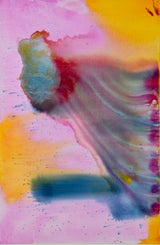How to trust a camel in blue.
SKU:
£2,200.00
£2,200.00
Unavailable
per item
90x60cm, 36x24 inches
Acrylic on canvas, 2020
£2,200 / €2,500
To purchase this painting, please click "Add to cart" below. Alternatively, to request an invoice for bank transfer payment, email: [email protected]
How to trust a camel blue.
Similarities between a painting and its owner matter most when they’re rare. They bond when they share uncommon commonalities, which allow them to feel that they fit in and stand out at the same time. Though the late Egyptians were fascinated with lapis lazuli, though they never discovered how to create pigments with the mineral. Not until the 6th century did the color blue emerge as a true pigment when it appeared in Buddhist paintings in Afghanistan. The pigment was eventually imported into Europe by Italian traders in the 14th and 15 centuries, where it was renamed “ultramarine.” In Latin, ultramarinus translates to “beyond the sea.” It soon became the most sought-after color in medieval Europe, with a price tag that rivaled that of gold. Prussian blue, also referred to as Berliner Blau, was accidentally discovered by German dye-maker Johann Jacob Diesbach in 1704. Diesbach intended on creating a new red hue, but his compound potash came in contact with animal blood. While he assumed this interaction would make the pigment more red, it instead created a surprising chemical reaction that produced a vibrant blue.
Similarities between a painting and its owner matter most when they’re rare. They bond when they share uncommon commonalities, which allow them to feel that they fit in and stand out at the same time. Though the late Egyptians were fascinated with lapis lazuli, though they never discovered how to create pigments with the mineral. Not until the 6th century did the color blue emerge as a true pigment when it appeared in Buddhist paintings in Afghanistan. The pigment was eventually imported into Europe by Italian traders in the 14th and 15 centuries, where it was renamed “ultramarine.” In Latin, ultramarinus translates to “beyond the sea.” It soon became the most sought-after color in medieval Europe, with a price tag that rivaled that of gold. Prussian blue, also referred to as Berliner Blau, was accidentally discovered by German dye-maker Johann Jacob Diesbach in 1704. Diesbach intended on creating a new red hue, but his compound potash came in contact with animal blood. While he assumed this interaction would make the pigment more red, it instead created a surprising chemical reaction that produced a vibrant blue.


